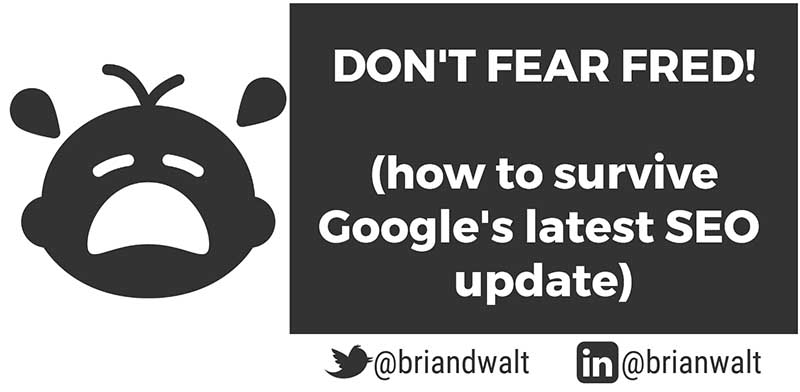Google has always been upfront in saying that they consistently make updates to their search algorithms. In late 2016, many in the search engine optimization industry knew something big was coming. Then it was no surprise that Google made a rather significant SEO update to its search algorithm in early March 2017, code named “Fred.” Despite numerous warnings many marketers are beginning to panic when they should be rethinking their approach to search optimization with a special emphasis on the experience they provide.
Fred can be your friend when you get to know him. When you understand his likes and dislikes in regard to a web experience you’ll find yourself generating more organic traffic.
What does Fred like?
Google has acknowledged that it actually makes hundreds of updates each year to its core algorithm. Fortunately, most updates of this size (and pretty much all updates for that matter) tend to focus on the same variables; either links or content.
Essentially if organic traffic was impacted it was because the site was in violation of the webmaster guidelines on quality. There is no way to know for sure what the focus of Fred may have been. It appears that the vast majority of the sites impacted seem to be content related and those which were negatively impacted had two things in common – their content was “shallow” and their website prioritized advertising over the experience of the user.
This is merely a highly educated guess based on certain changes sites have reported. Either way the impact has been quite substantial for sites that primarily use a model where advertising hinders the digital experience of the user.
The damage is done
Hopefully you weren’t one of the webmasters that reported 50-90 percent reductions in their organic traffic from Google. That size drop in traffic is serious, but there are some things we can do and some things that we most certainly should not do.
The last thing companies want to do is to panic! Do not start deleting pages without reason or modifying URL structures. While it is possible in the experience of many to get some traffic back over time, most of those that have employed tactics outside the Google’s Webmaster guidelines. You’re not likely to simply abandon their sites instead of put in the required work to fix their mistakes and get on the right track.
What to do next
Should your website be one of those impacted and you would like to regain its rankings (and why wouldn’t you), there are some steps that can be taken. If the ads on the site are the reason for the decline you must first consider how to monetize moving forward.
Are there simply too many ad units on the page? More than one popup for a mobile user could “ding” your SEO score. Many site owners will need to take a hard look at how to generate revenue. Finding shallow content is easy to identify and take some corrective actions. Start by identifying pages which suffered a reduction in traffic and begin including additional relevant content that is useful to users. If you don’t understand this SEO update, then it’s time to hire a expert
While we’ve made this seem simple, it is (in theory). There will need to be additional research and thought put into your content, but making these changes to your ongoing marketing plan will be increasingly necessary for success.
By Brian Walt – Marketing Expert
Twitter: https://twitter.com/briandwalt
LinkedIn: https://www.linkedin.com/in/brianwalt/
About Brian Walt
Brian has spent the better part of the past 8 years in entrepreneur / startup marketing roles becoming an established thought-leader on communications, marketing, and travel.
Passion for exploring the world has allowed him to lead a location independent lifestyle since 2013. He’s traveled to over 50 countries throughout the world with his family and draws from these experiences to become a better citizen and marketer.
When he isn’t working, playing with his boys, or trying to run a faster 5K, Brian can be found somewhere out in nature.





Leave A Comment